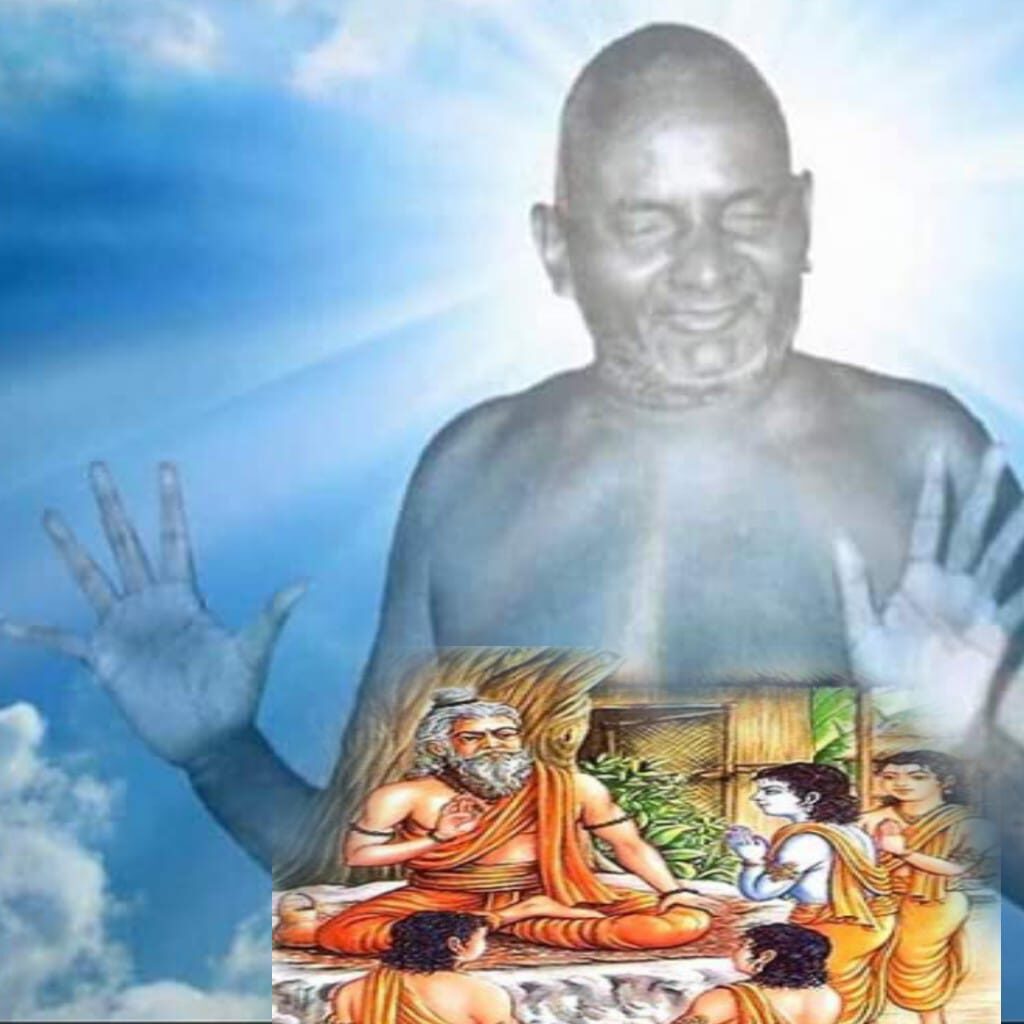
Mahamahim (His Majesty) Acharya Pippalada Maharshi is revered as Bhagavan Pippalada. He had the knowledge of the Param Rahasy (Ultimate Secret) of Srishti (Creation), Stithi (Maintenance), Laya (Dissolution), Parabrahma Stithi and the Jagatkaarana (the reason for the creation of the universe), and the realization that Karyaroop (result of it) of it is the universe had dawned in him. Six Rishiputras (sons of Rishis) approached Acharya Pippalada seeking for sanidhya samipya shishya vritti (discipleship under him, staying in his proximity) to learn the Brahmavidya Rahasy (Secret Knowledge of Brahma). They are,
- Sukesha son of Bharadwaja Rishi
- Satyakaama son of Shibhi
- Gargya/ Saurayane born in Gargya Gotra, grandson of Surya
- Kausalya son of Ashvala belonging to Bhrigu gotra
- Vaidharbhi
- Kabandhi son of Katya
These six Rishiputras asked their questions to Acharya Pippalada one by one.
First question
The first question was asked by Kabandi of Bhargavgotra, ‘O Venerable, Who is the Creator (Srishtikart)?’ Acharya replied ‘Prajapati is the Creator’, and elucidated ‘through His Sankalp (volition) the universe is created (Jagajjanana). In the creation, there are cheatana (moving) and achetana (non-moving) beings. There are five divisions in chetana like Pashu (animal), Pakshi (Bird), Deva (Divine being), Manava (Human being), etc. There are Panchabhuthas (five elements), Prithvi (Earth), Apa (water), Tejas (Fire), Vayu (Air), and Akasha (ether), out of these Prithvi, Apa, and Tejas are Murtas (corporeal) and the rest are Amurtas (incorporeal). Made through the panchabhutas in varied proportions they are diverse from each other.
After the Panchabhutas, Prajapati generated Prana and Rayi, the result of their coalescence is Creation. Prana is Purusha, Rayi is Prakriti; Aditya (sun) is Prana, Moon is Rayi; if Uttarayana is Prana then Dakshinayana is Rayi; Day is Prana, night is Rayi. Paramatma is the Prapta (attained/ the Absolute); Parabrahma is the one who illumines the Sun; Paramathma is Shariri, Jeeva is Sharira, everything is under Parabrahma. Aathmopasakas (seekers of Truth) being theistic and learned reach the Paramapada (Ultimate destiny) through their devotion and intellectual powers. Through Shravana (listening), Manana (reflection), and Nididyasana (meditation) Paramapada is attainable. That itself is Mukti (liberation), there is no fear of death there.
Second Question;
Vaidarbhi asked the second question ‘Godman, There are movable beings here, also immovable beings, who are the deities protecting them? Out of these divine beings illumining the creation who is the sovereign of all? Acharya replied ‘Mukhyaprana is the base for all the creatures. The unification of panchapranas is Mukhyaprana. Mukhyaprana bestows rains, food to the earth and creates water in the form of Indra, agni, Surya, Chandra, and Vayu; propitiates being in mother, father and even the fetus in the womb; as Prajapati takes on the forms of Indra, Chandra, Surya, Rudra, Vishnu and all-compassing (sarva shabda vachya); dissolver of the universe, also the protector; Mukhyaprana sheshi, that is, we are all its remnants.
Third Question;
Then Kausalya came and asked ‘Whence is this Mukkyaprana born? How would prana enter the body? How does he divide himself into five pranas (panchapranas)? Why does he egress (utkraman)? The magnificence of Mukyaprana is still dependent / presupposed (sakshepa), not a natural pure state (nitya siddha), what is superior to Mukhyaprana? Guru answered ‘This surpasses all the questions, you are Brahmanishta (true seeker of Brahma), and you are worthy. I will tell you succinctly’. Maharshi was welled with joy to hear the subtle inquiries of the transcendental nature of the Brahma, he had a real seeker of Brahma with him. He expounded ‘Paabrahma is the father and god of Mukyaprana. When jeevathmas experience the consequence of their virtues and vices, Mukhyaprana enters. Jiva and pranas are like person and shadow, Mukhyaprana is the king, rest panchapranas are Kinkaras, servants. They reside in different parts of the body. If Pran Vayu stays in the heart, Apanavayu takes care of excretory functions being in genital areas, Udanavayu works through eyes, ears, nose staying there, and Samaanavayu radiates in Jatharagni.
The heart is the place of the jiva, it has 101 nadis and each has 72 subdivisions, and in that each Nadi has 1000 nadis with 100 and odd branches. Among which permeates Vyana Vayu in all these. Udanayayu, when jiva is virtuous, is in an upward trend (urdwamukha) which takes the jiva to heaven (brahmarandra), if it’s a sinner it pushes jiva to hell. The world is Gatishila (dependent on time), creatures are Kriyashila (dependent on the action), virtues, and vices are the result of actions (kriyaphala), depending on that Udanavayu takes the jiva in either Urdwamukha (upward spiral) or Adhomukha (downward spiral). Panchabhutas and Panchapranas are related; Drik Shakti present in the eyes is through Aditya praana (tejas from sun) only. The agni on earth makes apanavayu flow downward (adhomukh). Samaana is the vayu between pritvi and dyulokha (heaven) and Vyana is in between samaana and akasha. The fire is verily udana, when it extinguishes, udana vayu departs, Jatharagni’s heat reduces, and mind absorbed in senses (indriyas) takes jiva from one body to the other. Seeker of praana is mumukshu, only he attains liberation, liberation is amritattva (immortality). Out of six devotees, Kausalya is the one who asked the vital question; hence he is Brahmajijnasu shishyotthama (supreme disciple). Questions from others were not directly focussed and narrowed on Paramatma Tattva. Kausalya asked regarding the birth of Mukhyaprana and the guru replied that it’s from Parabrahm only, this question proves that Kausalya deserves Brahma Vidhya.
Fourth Question;
Saurayani Gargya asked ‘Revered, when the jiva is sleeping, which are the organs that sleep? Which are those organs that remain awake? When does the jiva dream? Who experiences the pain and pleasures? On what are they established? Pippalada said ‘This question is about paratattva prakasha (light of supreme principle). As the rays of the setting sun become united in the orb of light and while rising they again disperse, so is mind. While awake, the focus is on senses and they are the means of light but in sleep, its different, sense organs go to sleep, in sushupti, jivatma merges in paramatma. In sleep jiva reaches the all-pervasive abode of brahma, puritat nadi, the mind merges there in sushupti. Before the sushupti is the dream and jivathma is the one who experiences dream, there is no dreaming in sushupti. There is one more parable of birds, they depart the nest in the morning and return in the evening. Similarly, senses, mind, panchaprana, and jiva merge in sushupti. Paramatma is Shuddh (pure), and akhilaheyapratyanika (abode of all that is good). He is indestructible. Parabrahma is the outcome of seeking Paramatma. Both Upaya and Upeya are Paramatma and Parabrahma only.
Fifth question;
Shaibya Satyakama asked ‘Revered, what is Pranavopasana sadhana (meditating on primordial sound Om)?’Acharya replied ‘Brahmavachi Pranav is of three kinds (trividha). Ekamaatrakalika (one syllable A), Dvimaatrakalika (two syllables AU), Trimaatrakalika (three syllables AUM). Eka and Dvimatra kalika omkaras are apara brahmavachaka (lower brahma/ manifested hiranyagarbha), they are called hrasva pranavas (short. Eka matra pranavopasaka reaches the mritylok (world of men/mortals), The Rik mantras (first matra A) takes him there. He incarnates again as human but he attains greatness in life through pranavopasana, being endowed with tapas (austerity), brahmacharyanishta (continence), and faith. Yajumantras take Dvimatrakalika Pranavopasakas to Somaloka (world of Moon), after enjoying the grandeur there then he returns to earth when the account of good deeds is balanced. Trimatravadhi pranavopasaka is taken to the Vaikunta in Saamagana (hymns from Sama), one attains Parabrahma (Supreme Being) there. These are the fruits borne of Pranavopasana. One must have a cogent discretion of different maatras and their significance in Pranavopasana.
Sixth Question;
Sukesha asked the sixth question which was asked by Hiranyaanabha, king of Kosala, to him, ‘Oh venerable, who is the Shodashakalatmaka purusha (person of sixteen kalas)? Where is he?’ Pippalada replied ‘Here, inside this body only. Those kalas are only the reason for bhoga- enjoyment, and endurance, this is also a creation of God, but the Jiva is Bhogi (endurer). The first kala is Mukhyaprana, rest fifteen are Shraddha (devotion), Panchabhutha (five elements), Indriyas (senses), Manas (mind), Anna (food), Veerya (semen), Tapa (penance), Karma (action), and Lokas (realms). Finally, the Shodoshakalas dissolve in Sahasrashirsha Purusha like how the rivers merge in the Ocean. Their basic origin is Parabrahma only. On those the Parabrahma laya (dissolving in Parabrahma) dawns upon, even death cannot touch them. The awareness that Parabrahma is Seematita (beyond boundaries), Aparichinna (not limited by space, time, concepts, objects), and Ananta (infinite, endless) is Brahma.
Reading and comprehending this Parabrahma Tattva, let us chant and worship Parabrahma Nityananda, the very incarnate of Parabrahma, ‘Om Namo Bhagavathe Nityanandaya’, and then meditate Silence.
Namo Nityanandaya
Compiled by: Swamy Vijayananda
English Translation: Ramya Poojari

